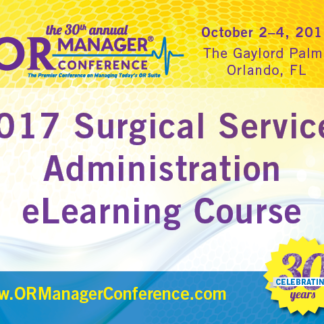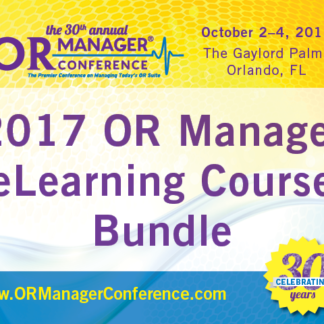Description
This package includes Finance and Process Improvement session recordings compiled from breakout and general sessions at the 2022 OR Business Management Conference. After viewing the content, complete a brief quiz and evaluation to earn 7 CEs.
Presentations include:
- Managing Cost of Surgical Care: Unforeseen Opportunities Caring for Patients Amid a Pandemic
- Bundled Payment Strategies – Is it a fit for your center?
- Financial Implications of Unprofessional Behavior in the OR
- Partnering with Finance to Align Billing with OR Resource Intensity
- Organize the Chaos and Make Room for Process Improvement and Professional Growth
- Ten Commandments: Rules of Engagement for Strengthening Interdisciplinary Partnerships
- Tame the Beast: Right-Size Your Surgical Supply Inventory
Learn more about the sessions below:
Managing Cost of Surgical Care: Unforeseen Opportunities Caring for Patients Amid a Pandemic
Escalating costs in today’s perioperative environment are a significant concern, undermining the financial viability of many hospitals amid the pandemic. Hospitals are facing extraordinary challenges effectively balancing the cost of clinical care, managing escalating medical supply costs, and addressing capacity issues with higher acuity and increased co-morbidities among patients. Creating a multifaceted approach to address these issues requires “all hands-on-deck” and innovative solutions led collectively by nurses, physicians, and hospital administrators.
A tertiary, academic medical center has implemented a multidimensional strategy to effectively address and monitor these issues. The roadmap begins with ensuring the clinical care is completed in the most appropriate environment. Transitioning elective outpatient procedures from a traditional inpatient OR environment to an ambulatory setting is not only cost effective, but is often driven by patient- and family-centered care amenities. The team developed a methodology to review elective outpatient procedures based on clinical, regulatory, environment, supplies and equipment, and staffing competencies required for the procedures.
The ability to transition elective outpatient procedures to the appropriate environment of care also created additional capacity for the surgical inpatient hospital needs. Providing cost transparency information to the surgeons and clinical teams created the opportunity to decrease cost of care by creating a cost-per-case receipt at the conclusion of each surgical procedure. Optimizing inventory and supplies by increasing ownership among the multidisciplinary committee managing value analysis, new product entry, and supply standardization created additional savings.
Learning Objectives:
- Describe innovative strategies to ensure high quality care in an era of a rapidly changing financial landscape.
- Define three strategies to reduce overall cost of surgical care and ensure quality outcomes.
- Assess the strategies to successfully transition surgical outpatient procedures performed in an inpatient hospital environment to an ambulatory surgery center.
Bundled Payment Strategies – Is it a fit for your center?
ASC’s play an important role in the value-based care environment. Those that are poised with the ability to provide a bundled payment strategy can leverage this as a financial opportunity. Bundled payments can be used with commercial payer negotiations, to contract directly with self-funded employers, as well as to attract cash paying healthcare consumers. This session will define the bundle payment strategy and provide insights in determining if it is a fit for your center as well as practical steps for implementation.
Learning Objectives:
- Define a bundle payment strategy and the value it can provide.
- Discuss key points to determine if it is a fit for your surgical center.
- Discuss steps for effective implementation of a bundle patient strategy.
Financial Implications of Unprofessional Behavior in the OR
This interactive presentation will focus on the financial and quality implications of unprofessional behavior in the OR. Participants will define behavior that is a risk to patient safety and leads to poor outcomes; discuss the importance of a culture where co-workers feel safe to report these behaviors and trust the organization will address them; and become familiar with a process to address patterns of behavior inconsistent with the values of the organization. Attendees will be able to define unprofessional behavior in the OR and its impact on team effectiveness and patient outcomes; discuss research that associates unprofessional behavior with higher malpractice costs and poorer surgical outcomes; and identify a tool and process to promote professional accountability and address observations of unprofessional behavior in the OR.
Learning Objectives:
- Define unprofessional behavior in the OR and its impact on team effectiveness and patient outcomes.
- Discuss research that associates unprofessional behavior with higher malpractice costs and poorer surgical outcomes.
- Identify a tool and process to Promote Professional Accountability and address observations of unprofessional behavior in the OR.
Partnering with Finance to Align Billing with OR Resource Intensity
Boston Children’s Hospital was historically applying a flat time charge regardless of the resource intensity of an operative case. The opportunity to reassess this structure was raised previously but never successfully implemented. This presentation describes the partnership between OR leadership and the finance department to internally create a scoring process, communicate and develop acceptance for the change, implement and monitor the levels, and provide ongoing reporting of the financial impact of the change.
The aim of this was to meet the following goals: 1) Assign a lower and more competitive time charge for the types of cases that are done on a community setting. 2) Capture additional revenue for the cases where Boston Children’s Hospital is a destination for care and to better align the revenue with the underlying additional staffing or equipment expenses of the operation. 3) Align ourselves with the more common leveled pricing that is seen elsewhere in the market.
Given that this was implemented during the time that services were ramping back up from reductions due to COVID-19, the financial impact of this change was beyond expectations. As part of the strategy, this new model poised us to more accurately charge a higher rate for the higher acuity cases. It was put in place to be revenue neutral, but in the end, we were able to benefit from the increased acuity. A secondary gain was that we had developed a measurement of acuity based on how we developed these levels. We could more accurately describe the increase in resource intensity of cases over time, both how it relates to direct staffing and supply usage as well as preoperative planning and assessments that are necessary with increased case intensity.
Learning Objectives:
- Identify internally developed operative acuity measures.
- Define the financial impact to pricing and chargemaster changes.
- Discuss partnering with operations and finance.
Organize the Chaos and Make Room for Process Improvement and Professional Growth
The day-to-day logistics of an OR, procedural area, or central sterile supply room are enough to keep hundreds of staff busy 24/7. Concurrent with the core functionality of the department, OR staff are also asked to manage and direct process improvement projects, facilitate change management, develop staff, and create bench strength for their teams. At our organization, we have a culture that is constantly looking for better ways to achieve outcomes and increase efficiency. We start multiple projects and then find our staff trying to determine how to do their “day jobs” plus this work. We needed to align the right people with the right opportunities and find the time to make it happen.
In this presentation, we will outline the tools we used to inventory the capacity of our team members, the daily work taking place, the additional projects we wanted to tackle, and what our staff needed from leadership to grow and develop professionally. This inventory led to a shift both tactically and strategically in how we approach our work, giving special consideration to resource involvement and alignment with long term strategy. We will summarize the benefits we have seen from this change, including clear communication and advancement of work using common templates and work structures, as well as additional allowances for staff to develop professionally. Audience members will be provided with take-home tools to replicate these exercises at their own institutions.
Learning Objectives:
- Describe the processes used to inventory resources and work to identify opportunities.
- Discuss new methodologies to structure the time of team members to allow for routine work, project work and professional development.
- Discuss the common tools to facilitate project advancement.
Ten Commandments: Rules of Engagement for Strengthening Interdisciplinary Partnerships
Market forces and healthcare reform require nimble, creative teams to ensure ongoing delivery of innovative, high-quality care while keeping organizations solvent. Within hospitals, this requires input from many stakeholders including physicians, nurses, and hospital administrators. To be most effective, interdisciplinary alliances must transcend cooperation to form true partnerships. While diverse perspectives have been shown to produce enhanced outcomes, leveraging them is often challenging due to the differences in focus and priorities, distrust, and tension between clinical and non-clinical disciplines.
In this breakout session, the speakers will share their experiences in building strong, interdisciplinary partnerships as well as a framework to support shared governance in their institution. This session will illustrate how galvanizing diverse backgrounds and viewpoints led to cost savings and enhanced patient outcomes.
Learning Objectives:
- Define a framework to support shared governance.
- Identify steps for building interdisciplinary partnerships.
- Discuss characteristics of strong, collaborative partnerships.
Tame the Beast: Right-Size Your Surgical Supply Inventory
The surgical supply inventory can be overwhelming, but Cincinnati Children’s Hospital Medical Center (CCHMC) has successfully used a multidisciplinary, data-driven approach to right-size and distribute its surgical supplies. The approach blends data-driven decision making with engagement from frontline clinical staff to make best use of limited staff, space, and budget. CCHMC has identified opportunities for nearly $2 million in savings by reducing low and slow-moving items and adjusting par levels to more closely match supply with demand. Attend this session to discover how to harness the power of data and staff to increase efficiency.
Learning Objectives:
- Discuss how to complement inventory management efforts with data-driven metrics.
- Develop a framework for evidence-based management of surgical supplies.
- Describe strategies for partnering with clinical and nonclinical stakeholders.


